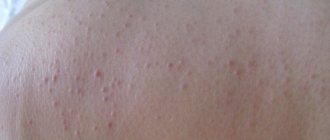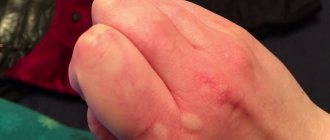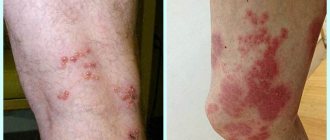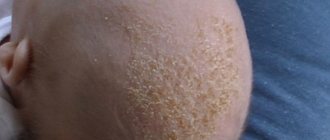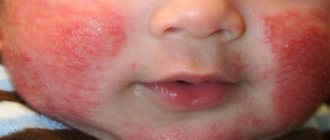Harm and benefit
Of course, no one can deny the benefits of such products.
The main component of sweets are carbohydrates, which are a source of energy for the human body.
They are absorbed quite quickly and help satisfy hunger in a short time.
An equally important property of sweets is their ability to lift a person’s mood.
At the same time, there is considerable harm from consuming such products.
Although sweets quickly satisfy hunger, they also quickly provoke it.
In healthy people, the level of insulin in the blood increases in a short time.
In addition, sweet foods can lead to psychological dependence on their consumption.
Ultimately, excessive consumption of sweets can cause sudden weight gain.
One of the most common disorders that such products can cause is allergies.
Sahara
The main component of sugar that can trigger the development of this disease is sucrose.
When this substance is incompletely fermented, an immune response develops in the human body.
The severity of the reaction is directly affected by the amount of sugar consumed.
However, sucrose is quite rarely a true allergen.
It only enhances the processes of putrefaction and fermentation in the intestines and thereby stimulates reactions to other substances.
Both white and brown sugar can cause allergies.
At the same time, cane sugar is still considered more useful and is even recommended for use by allergy sufferers.
However, in reality it is quite difficult to predict the body's reaction to this product.
A person may have an individual intolerance to brown sugar.
In addition, it is considered an exotic product, which is also dangerous for allergy sufferers.
Storage and manufacturing conditions are of no small importance.
An allergic reaction may occur not to the product itself, but to impurities in its composition.
Therefore, we can conclude that any sugar can cause allergies.
Sweetener
Allergies can also be a consequence of consuming sweeteners.
The instructions for some of them list skin reactions as side effects.
In particular, we are talking about a sweetener called suclamate.
Photo: Small itchy rash
Chocolate and chocolate candies
Chocolate contains quite a few allergens, which differ in protein origin.
Allergic reactions to this product occur especially often in childhood.
Doctors do not advise giving chocolate to children under 2.5 years of age, as this can cause cross-allergy.
The symptoms of this disease directly depend on the severity of the reaction, but in most cases they manifest themselves in the form of skin rashes.
An allergy to candy is a consequence of incomplete breakdown of sucrose in the intestines, which is accompanied by the fermentation process.
As a result, the resulting products enter the bloodstream and provoke undesirable reactions.
The reaction to sweets in children is congenital, but often it is acquired due to the consumption of excessive amounts of sweets.
The increase in symptoms of the disease is provoked by chocolates.
Cakes and pastries
The simplest cake or pastry contains various elements - in particular, milk and eggs.
It is these products, which are often used to make such baked goods, that most often provoke allergies.
Also, cakes often contain fruit or lemon zest - these can also become the culprits of the disease.
Manufacturers often add artificially synthesized compounds to confectionery products, which help give them a certain smell or color.
Such components can also provoke the development of the disease.
Causes
An allergy to sweets is a consequence of a disruption in the digestion of foods that contain sucrose.
The deficiency of the enzyme that breaks down this carbohydrate leads to the development of fermentation processes in the intestines.
As a result, intermediate products of sucrose breakdown enter the bloodstream, which provokes the development of an immune reaction.
For a full-fledged allergic reaction to occur, two components are required - sucrase deficiency and an incorrect formation of the immune response to the entry of antigen from the intestines.
If the immune response is disrupted, an allergy also appears to products without sucrose, but with the presence of foreign proteins in the composition. These include:
- chocolate;
- nuts;
- cocoa.
These substances are often included in confectionery products, which also leads to the appearance of symptoms of the disease.
In adults, allergic reactions to sweets occur much less frequently than in children.
However, they have a similar mechanism and are associated with the consumption of chocolate, peanuts and citrus fruits.
Diagnostics
Detection of allergies to sweets is carried out using the following methods:
- Blood test for immunoglobulin levels. It involves collecting venous blood from the patient. The allergen is introduced into the sample taken. Based on the reaction, the allergist is able to determine the presence or absence of a false allergy in a person.
- Conducting skin tests by applying an allergic substance to or under the skin.
- Conducting provocative tests through the patient's consumption of products containing allergens. If a reaction appears after half an hour or an hour, a diagnosis is made. The method is rarely used due to its danger and unpredictability for the health of patients. After the test, the person must be under the supervision of allergists for 24 hours.
Allergen test
Skin testing for allergens is often used. One of the common forms of diagnosis is a prick test by applying an allergen to various areas of the patient’s skin. A change in the color of the reagent will indicate the development of an allergy in a person.
In some cases, the allergen is injected under the patient's skin. After a couple of hours, the sample result is examined.
Allergen tests are not performed on small children under 3 years of age. For them, the only possible diagnostic method is a safe blood test.
Related factors
Additional factors can lead to the development of allergic reactions to sweet foods:
- genetic predisposition;
- early onset of sensitivity to an allergen - this often occurs in the womb;
- effects on the body of cigarette smoke, industrial waste;
- a sharp change in hormonal levels - this often occurs during pregnancy, menstruation, puberty or menopause;
- helminthic infestations;
- excessive consumption of sweets.
If you have a disease, it is not at all necessary to eat cakes or pastries.
Sometimes it is enough to eat fruits that contain sucrose.
A reaction to lactose, milk sugar, is also quite common.
Successful preventive actions
To minimize the risk of developing a sweet intolerance, it is important to take the following steps:
- limit the consumption of alcohol and tobacco products;
- organize your diet and eat right;
- show moderate interest in sports;
- increase the protective functions of the immune system;
- If you have chronic diseases, then it is necessary to quickly and competently suppress attacks.
It is important for children to have helminthic infestations. If this is not done, harmful substances may cause the next case of allergies.
How does a sweet allergy manifest?
In adults and children, this disease has the same symptoms:
- skin rashes on different parts of the body - most often the rash is localized on the cheeks, buttocks, abdomen, neck;
- attacks of suffocation;
- the appearance of itching in the area of the rash;
- allergic rhinitis;
- hives;
- stomatitis;
- headache;
- anaphylactic shock;
- inflammation of the mucous membranes and lips;
- bronchospasms;
- sneezing;
- Quincke's edema.
Symptoms of a sweet allergy may not appear immediately, but only after a certain time.
The most dangerous for humans are Quincke's edema and anaphylactic shock, which can cause death.
Many studies prove that signs of sensitization are associated not with the sweets themselves, but with the intolerable ingredients included in their composition.
This could be a leavening agent, flavoring, or other additive.
If you exclude it from the diet, it is quite possible to eat sweets.
If a person has a reaction to confectionery products, this does not mean that one should completely abandon such products.
The fact is that they contain glucose, without which many body systems cannot function.
If you completely abandon this substance, the following symptoms appear:
- insomnia;
- irritability;
- constant feeling of fatigue;
- discomfort;
- stressful situations;
- depression;
- loss of control over one's actions.
To avoid such consequences, you need to properly organize your own diet, and if necessary, then undergo a course of therapy.
Photo: Reaction to sweets
Obvious manifestations in adults
The following symptoms are observed:
- A cough begins, and quite rarely there are unusual cases of lack of air.
- There are signs similar to a cold: the nose gets clogged, frequent sneezing begins.
- Redness appears in the eyes and sensitivity to light increases.
- A common symptom is a rash on the face and other parts of the body from eating sweets in adults. It has varying degrees of difficulty.
- In the group with normal rashes, there is a burning sensation and itching, but these symptoms are dormant most of the time.
- Sweet urticaria - large spots with blisters. Rarely develops.
- Poor general condition of the body, as it begins to poison itself.
How do the symptoms of sweet allergy appear in adults in the photo:
Treatment
For treatment of a disease to be effective, it must be comprehensive.
To do this, you need to follow a number of recommendations:
- prevent the penetration of the allergen into the body. To prevent symptoms from occurring, it is best to avoid sweets completely.
- take antihistamines. Such drugs block histamine receptors. The doctor may prescribe suprastin, diazolin.
- use drugs for symptomatic therapy. Ointments and creams that have an anti-inflammatory effect will help cope with the symptoms of the disease on the skin. These include sinaflan, lokoid.
- cleanse the intestines using sorbents. Such agents bind the allergen in the intestines, preventing it from entering the blood. This category includes smecta, enterosgel.
In the process of treating allergic reactions, it is very important to pay attention to the normalization of carbohydrate digestion processes.
For this, the doctor prescribes enzyme preparations:
- mezim;
- festal
They are also actively used for preventive purposes.
Read about the symptoms of an allergy to hairspray. Is it possible to be allergic to eggs? Follow the link.
Who should I contact?
At the first symptoms of an allergy, it is recommended to seek help from a therapist. He will examine the patient, rule out other possible diseases, give a referral to an allergist for a skin test, and draw up an effective treatment regimen. It is important to strictly adhere to it and not neglect repeated appointments - the doctor will objectively assess the patient’s current condition and prescribe hormone-containing drugs if the prescribed therapy has not brought visible results.
If allergy symptoms develop rapidly, a suffocating cough, swelling, weeping inflammation, and other alarming signals appear, you should immediately call an ambulance.
Dietary recommendations
After testing, it is necessary to exclude all products that contain an allergen.
In addition, it is important to significantly limit the consumption of confectionery and all products containing sugar, including milk protein.
The following products should predominate in the diet:
- vegetables;
- herbal teas;
- weak broths;
- porridge;
- whole wheat bread;
- baked goods without added sugar.
At the same time, the menu should not contain products that accelerate the entry of allergenic substances into the blood:
- fish;
- smoked meats;
- mustard;
- pepper;
- eggs;
- canned food;
- mayonnaise;
- vinegar;
- garlic;
- onion;
- horseradish;
- tomato juice.
Instead of sweet foods, you can use natural desserts:
- jelly;
- fruits;
- jelly;
- berries;
- dried fruits;
- compotes.
To make homemade baked goods, sugar can be replaced with stevia.
It is also quite acceptable to use sweet fruits - for example, banana.
Simple tricks
Of course, giving up sweets completely can be quite difficult.
However, doctors do not recommend completely excluding confectionery products from the diet, because the glucose they contain is necessary for the human body.
To minimize the negative impact of sweets on the human body:
- it is necessary to consume sweets in limited quantities;
- it is also very important to include a sufficient amount of clean water in the diet, which will ensure the removal of harmful substances from the body;
- Adequate physical activity also helps improve the condition of an allergy sufferer. Doing daily morning exercises will help you eat small amounts of sweets without much harm to your health.
Read what to do if you are allergic to chocolate. How does a coffee allergy manifest? The answer is here.
What to do if you are allergic to hair dye? Click go.
